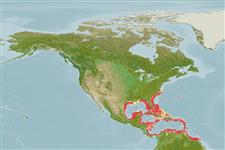Actinopterygii (peixes com raios nas barbatanas) >
Pleuronectiformes (Flatfishes) >
Paralichthyidae (Large-tooth flounders)
Etymology: Syacium: Greek, yagke, -es = cheek; diminutive (Cfr. Aaptosyax). More on author: Ginsburg.
Ambiente / Clima / Intervalo
Ecologia
; marinhas; estuarina associadas(os) a recifes; intervalo de profundidade 27 - 95 m (Ref. 7251). Tropical, preferred ?; - 6°N
Western Atlantic: northeastern Florida (USA), Gulf of Mexico, and the Antilles to Guyana.
Length at first maturity / Tamanho / Peso / Idade
Maturity: Lm 9.6, range 6 - ? cm
Max length : 20.0 cm TL macho/indeterminado; (Ref. 7251); common length : 15.0 cm TL macho/indeterminado; (Ref. 5217)
Found between the shore and 100 m depth, on sand or mud bottoms rich in organic matter. Feed mainly on shrimps (Penaeidae), amphipods, crustacean larvae and annelids. The whole life cycle develops on the continental shelf. During reproduction in May and September, adults gather in shallow waters of the estuaries and along the coast. Sexual activity takes place during the rainy season which corresponds to quite a large influx of organic matter, thereby ensuring food for the breeding fish. Sexual dimorphism affects the interorbital width and pectoral fin length of the hidden side. Juveniles remain planktonic for a long time with a high growth rate of >5% per day (Ref. 35237).
Life cycle and mating behavior
Maturidade | Reprodução | Desova | Ovos | Fecundidade | Larvas
Distinct pairing (Ref. 205).
Robins, C.R. and G.C. Ray, 1986. A field guide to Atlantic coast fishes of North America. Houghton Mifflin Company, Boston, U.S.A. 354 p. (Ref. 7251)
Status na Lista Vermelha da IUCN (Ref. 115185)
CITES (Ref. 94142)
Not Evaluated
Perigo para os humanos
Harmless
Uso pelos humanos
Pescarias: pouco comercial
Mais informação
ReferênciasAquaculturaPerfil para aquaculturaEstirpesGenéticaFrequência alélicaHereditariedadeDoençasProcessamentoMass conversion
Ferramentas
Relatórios especiais
Baixar XML
Fontes da internet
